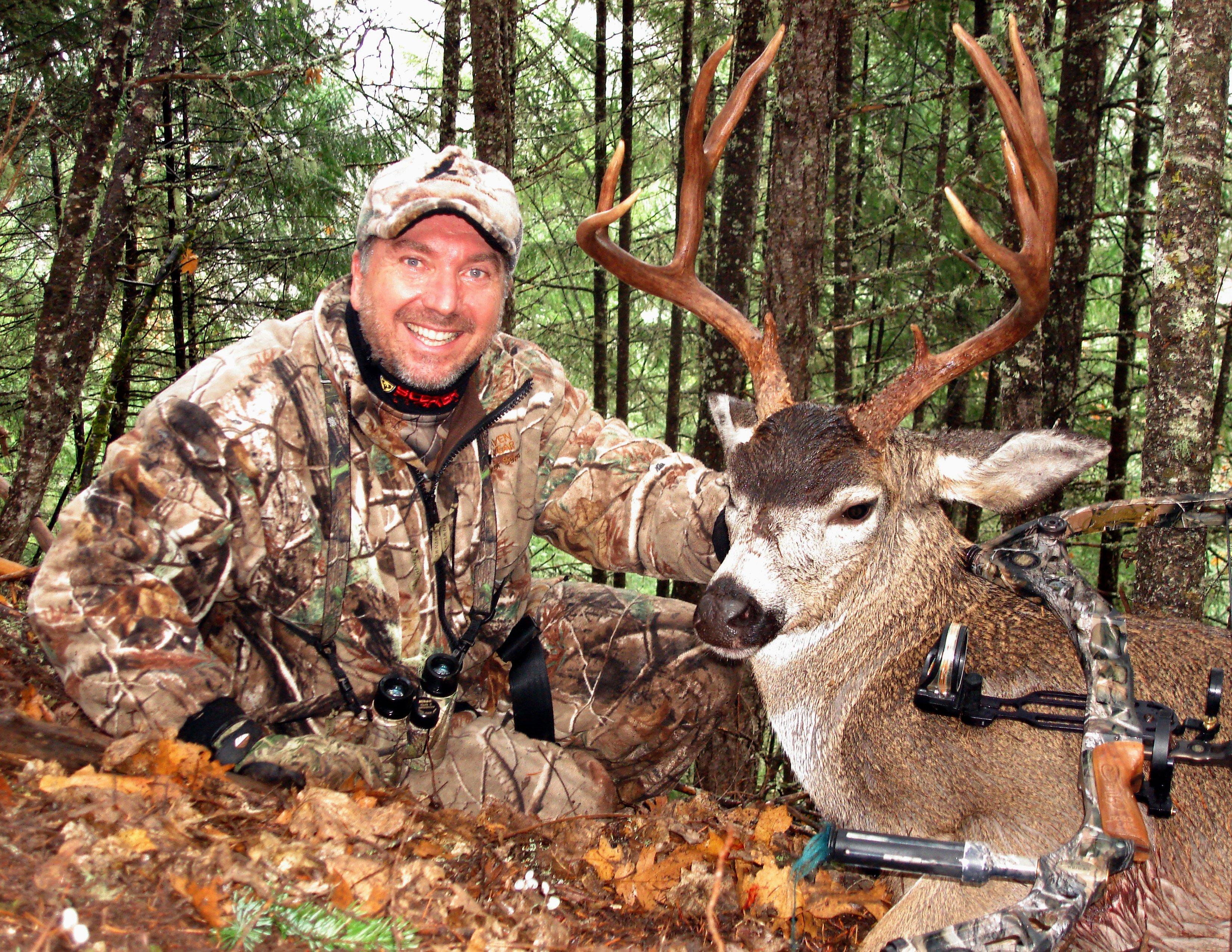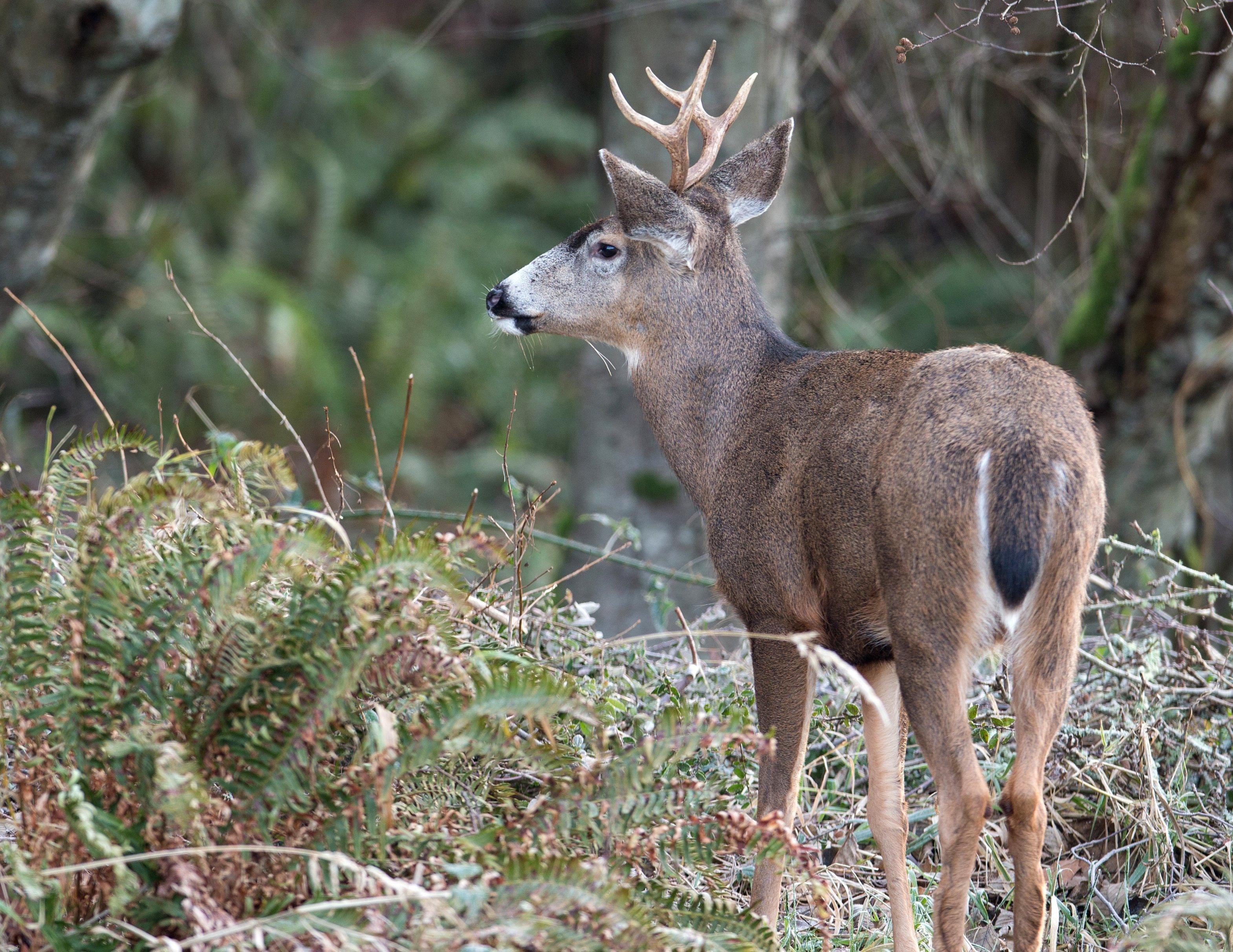A quest for these five deer species is attainable for even DIY hunters on a budget, but it won’t be easy. Here’s the rundown for getting started.

The mule deer is one of the five deer species recognized as part of the North American Deer Slam. (Photo courtesy of Tom Tietz)
The mule deer buck was bedded with several does and fawns, basking in the sun while a creek trickled nearby. I was 51 yards away, and waiting with an arrow on my bowstring. Would the buck stand up to stretch in 5 minutes or 5 hours? Time would tell.
Only 15 minutes later, he rose to his feet and quartered slightly away. I drew my bow, hovered my 50-yard pin on his side and launched my arrow. It arced seemingly high, and I panicked for a millisecond, but then it dropped perfectly into the boiler room. The buck bolted, making it only 40 yards before toppling over.
That buck, taken back in 2009, was my first muley. Having grown up and lived my life in whitetail country, it was a thrilling experience to try my hand at a different deer species using a new-to-me hunting style. If you’re a deer hunter through and through, perhaps you’ve dreamed of venturing out and trying something new, and perhaps evening tackling the North American Deer Slam. It’s a quest that will take you across the country, show you unbelievable landscapes, and provide unique challenges.
But what exactly is it? The short answer is that it entails harvesting all five of the following deer species: whitetail, mule deer, Coues whitetail, Columbian blacktail, and Sitka blacktail. But, let’s make an article out of it by discussing where these species reside, some of their behavioral traits, and common strategies hunters use to successfully harvest these deer.
Whitetail

Whitetails inhabit Maine to Washington State and Florida to Northeast New Mexico. They are the most pursued North American big game animal due to their abundance. However, large bucks are very challenging to outfox. (Photo by Dennis W. Donohue)
Whitetails are, hands down, the most available deer species, which is why hunters spend more time, money and effort hunting them than any other big game species on the planet. From Maine to Washington and Florida to northeastern New Mexico, opportunities to hunt whitetails abound. Whitetails are so adaptable and reside in the U.S.’s many diverse eco-regions, from the Texas Hill Country to the towering forests of Manitoba. And it isn’t tough to obtain a tag, as many states offer them over the counter.
If you’re into trophy hunting, the states with the most Boone & Crockett entries are Wisconsin, Ohio, Indiana, Kentucky, and Iowa. Keep in mind that a B&C-class whitetail is the elite. Bucks of that caliber are few and far between, and they are sharp as a tack. But, dedicated hunters manage to take lots of world-class bucks each year, especially in the Midwest, as the records books suggest.
A variety of tactics are effective on whitetails. Early-season bowhunters tend to hunt bed-to-feed patterns from treestands and ground blinds. During the rut, many shift their efforts to funnels and travel corridors. Some hunters sit over bait all season. Some flood the woods with trail cameras, while others prefer the element of surprise. Some firearms hunters enjoy comfortable box blinds, while others conduct drives to get deer on their feet during daylight. In a few areas, hunters track whitetails in freshly fallen snow, and out West, spot-and-stalk tactics rule. The takeaway is, whitetail hunting is largely available to everyone. The deer themselves aren’t easy to hunt, but this is the easiest of the five Deer Slam species to claim.
Mule Deer
Mule deer inhabit the shores of the Missouri River in North and South Dakota out to Eastern Washington and from Alberta clear down to Mexico. You’ll find muleys on pancake-flat deserts as well as above timberline in the Rockies. In some cases, their range overlaps whitetail country. A lot of big bucks come from Arizona, Colorado, Nevada, New Mexico, and Utah. The mule deer, as a whole, is declining across most of its range. Some challenges it faces are diseases, brutal mountain and plains winters, and habitat loss. But populations are stable in many areas, providing hunters with ample opportunity to hunt.

Mule deer inhabit much of the western U.S. from Canada to Mexico. Tom Miranda bow-killed this monster mule deer in Sonora, Mexico. (Photo courtesy of Tom Miranda)
Mule deer tags are usually more difficult to acquire than whitetail tags, and are issued by draw in most states. Limits and quotas ensure the longevity of this species, and it can take a few years’ worth of applying and banking preference points to finally secure a tag.
DON'T MISS: The Best Days to Deer Hunt in 2024
The classic way to hunt a mule deer, both with firearms and archery gear, is via spot and stalk. Muleys tend to inhabit more open terrain, where they’re easier to see and where hunters can stay on them from dawn to dusk. Granted, in more forested areas or around agriculture, a handful of hunters find success by hunting travel routes from treestands. I used this technique to kill one of my mule deer bucks during the late season on a wheat field. Muley bucks are also fighters, and some bowhunters find success by using calls and decoys.
Coues Whitetail
The diminutive Coues whitetail inhabits the high-desert mountains of Arizona, New Mexico, and Mexico. It has long been referred to as the Grey Ghost because it is tough to find due to its small size and wary nature. While a big northern whitetail can tip the scale at 300 pounds, the average mature Coues buck tops out at about 100 pounds. They have antlers to match. For perspective, the minimum score for Boone and Crockett is 170 for a typical whitetail and 180 for a typical mule deer, but a 100-inch Coues buck will make the book.

The Coues deer, found in Arizona, New Mexico, and Mexico, is a small subspecies of white-tailed deer. Mature bucks weigh around 100 pounds on the hoof and are incredibly elusive. (Photo by Sean R. Stubben)
Coues deer are especially difficult to spot, so extensive glassing with binoculars and spotting scopes is usually required to locate a good buck. From there, a stalk is planned. For rifle hunters, just finding a buck is often the most challenging part, although shots on Coues whitetails can be distant. Stalking into a bow range redefines the term “challenging.” Sneaking through the rocky, high-desert mountains is anything but quiet, and countless nooks and crannies can seem to vacuum up bucks almost as quickly as they’re located.
DON’T MISS: Don’t Kid Yourself: Weather and Moon Matter for Deer Hunting
In the pine forests where visibility is far more limited, bowhunters tend to treat the Coues rut much like the whitetail rut, hunting from treestands near terrain features that funnel movement, or even over scrapes. Some use trail cameras and some rattle and grunt to find routine success. Regardless of the tactic used, killing a mature Coues whitetail buck is a big accomplishment.
Columbian Blacktail
It takes a 125-inch Columbian blacktail to meet the Boone & Crockett minimum, and big bucks usually top out at about 150 pounds. Columbian blacktails closely resemble miniature mule deer. They inhabit the West Coast in British Columbia, Washington, Oregon, and California. Finding a mature buck, especially in the dense, rainforest-like habitats of the Pacific Northwest, is one of hunting’s greatest challenges and in fact, some hunters believe this one is the toughest to get on the Deer Slam list.

Tom Miranda arrowed this big Columbian blacktail in Oregon. This deer species is considered one of the most difficult to harvest with a bow. (Photo courtesy of Tom Miranda)
Hunting tactics can vary by region and the time of the season. Bowhunters can start hunting in July in California, when air temperatures can be in the 90s and 100s. Deer will be active for short periods in the mornings and evenings, and then retreat to the shade under oaks for the rest of the day where finding them can prove difficult. Spot and stalk hunting is the game here.
Columbian blacktails also inhabit the higher elevations of Washington’s Olympic range, where they can be hunted just like high-country mule deer. Old-time blacktail rifle hunters often walked clear-cuts on lower timber-company lands until they’d jump a buck. Columbian blacktails have a weakness in their inquisitive nature, and even mature animals will often stop to investigate the source of danger after being jumped — providing ready hunters with a good shot opportunity.
Consistently successful bowhunters who hunt Oregon and Washington log many hours in treestands, often hunting concentrations of does in hopes of catching a cruising buck as the rut draws near; this is the only time when a Columbia blacktail buck, which has a small home range, tends to cover much ground.
Sitka Blacktail
The Sitka blacktail provides a hunting adventure like no other deer species. Kodiak and Afognak Islands in Southeast Alaska are where hunters go to get their Sitka blacktail. Both islands are as wild as it gets, and the opportunity for the hunter to become the hunted exists, as colossal brown bears roam there, too. While hunting on Kodiak Island in October 2022, I encountered 13 different brown bears, and while none of them gave me any trouble, I was on my toes the entire time.

Sitka blacktails can be pursued on Southeast Alaska’s Kodiak and Afognak Islands where hunters will share the turf with massive brown bears. (Photo courtesy of Double Brow Imagery)
During my hunt, I utilized the services of a transporter. A transporter will put you into solid deer habitat, but by law cannot provide any current details about a deer’s whereabouts. So, it’s a DIY hunt, but sleeping and eating on a large fishing boat in a remote bay was far better than sleeping in a tent amongst the brown bears, especially because it rained multiple times during the weeklong hunt.
While some bowhunters find success at the highest elevations during the early season, the best action happens when cold weather and the rut align in November. Bucks that were once reclusive and confined to thick alders are liable to appear along the beach as they search for does and eat kelp.
DON’T MISS: When the Neighbor Kills Your Target Buck: Story of a Drop-Tine Georgia Giant
When bucks aren’t in the rut — this was the case during my October hunt — a good strategy is to sit and glass, and because of the amount of thick cover, you might consider still-hunting in order to bump a buck from his bed. If you’re hunting with a rifle, you’ll often get an opportunity to shoot, as these deer tend to be highly inquisitive like their Columbian cousins.
A Slam Within Reach
There are a lot of accomplishments in the hunting world that are simply out of reach for most hunters. Taking all 29 North American big game species, for example, costs hundreds of thousands of dollars. Going to Africa and killing the African Big 5? You guessed it: Extremely expensive. But a North American Deer Slam is far more reachable and something that a blue-collar hunter could realistically pull off with some budgeting and smart planning. If you didn’t know what the North American Deer Slam is, now you do. And perhaps you’re already inking it onto your bucket list.












